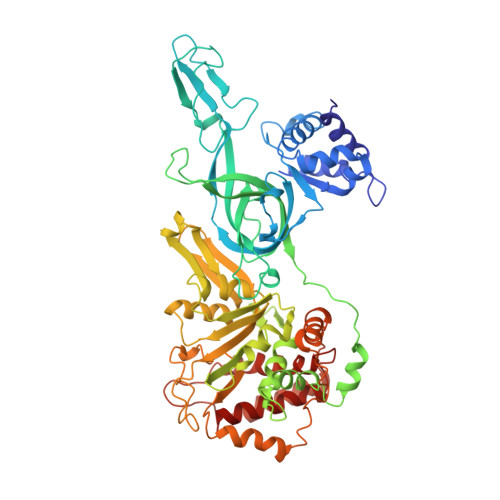Crystal structure of a near-full-length archaeal MCM: Functional insights for an AAA+ hexameric helicase.
Brewster, A.S., Wang, G., Yu, X., Greenleaf, W.B., Carazo, J.M., Tjajadia, M., Klein, M.G., Chen, X.S.(2008) Proc Natl Acad Sci U S A 105: 20191-20196
- PubMed: 19073923
- DOI: https://doi.org/10.1073/pnas.0808037105
- Primary Citation of Related Structures:
3F9V - PubMed Abstract:
The minichromosome maintenance protein (MCM) complex is an essential replicative helicase for DNA replication in Archaea and Eukaryotes. Whereas the eukaryotic complex consists of 6 homologous proteins (MCM2-7), the archaeon Sulfolobus solfataricus has only 1 MCM protein (ssoMCM), 6 subunits of which form a homohexamer. Here, we report a 4.35-A crystal structure of the near-full-length ssoMCM. The structure shows an elongated fold, with 5 subdomains that are organized into 2 large N- and C-terminal domains. A near-full-length ssoMCM hexamer generated based on the 6-fold symmetry of the N-terminal Methanothermobacter thermautotrophicus (mtMCM) hexamer shows intersubunit distances suitable for bonding contacts, including the interface around the ATP pocket. Four unusual beta-hairpins of each subunit are located inside the central channel or around the side channels in the hexamer. Additionally, the hexamer fits well into the double-hexamer EM map of mtMCM. Our mutational analysis of residues at the intersubunit interfaces and around the side channels demonstrates their critical roles for hexamerization and helicase function. These structural and biochemical results provide a basis for future study of the helicase mechanisms of the archaeal and eukaryotic MCM complexes in DNA replication.
Organizational Affiliation:
Molecular and Computational Biology, University of Southern California, Los Angeles, CA 90089, USA.














